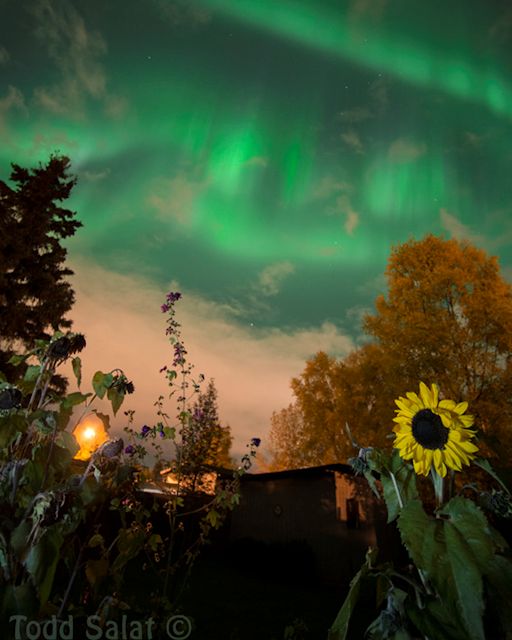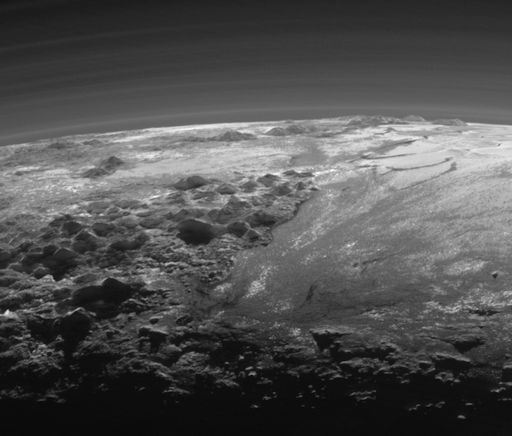On Sept. 27th, the Harvest Moon will pass through the shadow of Earth, turning the lunar disk a lovely shade of celestial red. Catch it live on the Internet, courtesy of the Coca-Cola Space Science Center in Columbus, Georgia. | | |
CME IMPACT SPARKS STRONG GEOMAGNETIC STORM: Arriving a full day earlier than expected, a CME hit Earth's magnetic field on Sept. 20th at approximately 0600 UT. The impact sparked a strong G3-class geomagnetic storm and bright auroras over high-latitude regions of North America. "It was a great light show," reports Todd Salat, who sends this picture from his backyard garden in Anchorage, Alaska:

"At first, I was planning to go watch the auroras from the nearby mountains, but decided to stay home because of this late but great six-foot tall sunflower!"says Salat. "I figured it was a unique opportunity to shoot the auroras over Helianthus."
The storm is subsiding now, but it could flare up again as Earth passes through the wake of the CME. NOAA forecasters estimate a 50% chance of more geomagnetic storming on Sept. 20-21. Aurora alerts: text or voice
Realtime Aurora Photo Gallery
INCREDIBLE NEW PHOTOS OF PLUTO: NASA is still downloading images from the Pluto flyby two months ago. Some of the new arrivals, like this one received on Sept. 13th, are causing researchers to question what they thought they knew about the distant dwarf planet:

New Horizons snapped the picture looking back at Pluto about 15 minutes after its closest approach on July 14th. Backlit by the sun, Pluto's rugged, icy mountains tower over a vast frozen plain extending to the horizon. The backlighting highlights more than a dozen layers of haze in Pluto's tenuous but distended atmosphere.
The new pictures provide evidence for a remarkably Earth-like "hydrological" cycle on Pluto – but involving soft and exotic ices, including nitrogen, rather than water ice. There are signs of hazes, evaporation, precipitation, and flowing glaciers similar to the frozen streams on the margins of ice caps on Greenland and Antarctica.
"We did not expect to find hints of a nitrogen-based glacial cycle on Pluto operating in the frigid conditions of the outer solar system," says Alan Howard, a member of the mission's science team from the University of Virginia. "Driven by dim sunlight, this would be directly comparable to the hydrological cycle that feeds ice caps on Earth, where water is evaporated from the oceans, falls as snow, and returns to the seas through glacial flow."
"Pluto is surprisingly Earth-like in this regard," adds Alan Stern, principal investigator of the New Horizons mission, "and no one predicted it."
Realtime Space Weather Photo Gallery
Realtime Sprite Photo Gallery
Realtime NLC Photo Gallery
Every night, a network of NASA all-sky cameras scans the skies above the United States for meteoritic fireballs. Automated software maintained by NASA's Meteoroid Environment Office calculates their orbits, velocity, penetration depth in Earth's atmosphere and many other characteristics. Daily results are presented here on Spaceweather.com.
On Sep. 20, 2015, the network reported 11 fireballs.
(11 sporadics)

In this diagram of the inner solar system, all of the fireball orbits intersect at a single point--Earth. The orbits are color-coded by velocity, from slow (red) to fast (blue). [Larger image] [movies]
Potentially Hazardous Asteroids (
PHAs) are space rocks larger than approximately 100m that can come closer to Earth than 0.05 AU. None of the known PHAs is on a collision course with our planet, although astronomers are finding
new ones all the time.
On September 20, 2015 there were 1611 potentially hazardous asteroids.
Notes: LD means "Lunar Distance." 1 LD = 384,401 km, the distance between Earth and the Moon. 1 LD also equals 0.00256 AU. MAG is the visual magnitude of the asteroid on the date of closest approach. | | The official U.S. government space weather bureau |
| | The first place to look for information about sundogs, pillars, rainbows and related phenomena. |
| | Researchers call it a "Hubble for the sun." SDO is the most advanced solar observatory ever. |
| | 3D views of the sun from NASA's Solar and Terrestrial Relations Observatory |
| | Realtime and archival images of the Sun from SOHO. |
| | from the NOAA Space Environment Center |
| | the underlying science of space weather |
| | Web-based high school science course with free enrollment |

